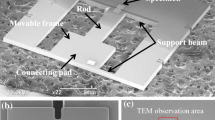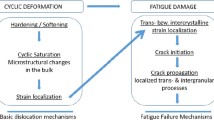Abstract
Fatigue crack growth tests are carried out on sheets of an Fe-3.2% Si single crystal with a crystallographic orientation appropriate for striation formation. The behaviour of slip near a crack tip during the loading and unloading parts of a fatigue cycle is observed using an Atomic Force Microscope and a Scanning Electron Microscope. The fracture surfaces are also analysed with an AFM and an SEM. The mechanism of fatigue crack growth is discussed based on the observations, and a fundamental kinematic model for fatigue crack growth is proposed. The model gives a reasonable explanation for both the crack growth and striation formation.
Similar content being viewed by others
References
Bowles, C.Q. and Broek, D. (1972). On the formation of fatigue striations. International Journal of Fracture Mechanics, 8, 75–85.
Budiansky, B. and Hutchinson, W. (1978). Analysis of closure in fatigue crack growth. Journal of Applied Mechanics 45, 267–276.
Forsyth, P.J.E. and Ryder, D.A. (1960). Fatigue fracture, some results derived from the microscopic examination of crack surfaces. Aircraft Engineering 32, 96–99.
Homma, H., Matsui, T. and Nakazawa, H. (1981). Analysis of steady state crack growth by discrete dislocation theory. Proceedings of 5th International Conference on Fracture 5, 2155–2160.
Kanninen, M.F., Atkinson, C. and Feddersen, C.E. (1977). A fatigue crack growth analysis method based on simple representation of crack tip plasticity. ASTM STP 637, 122–140.
Kikukawa, M., Jono, M. and Adachi, M. (1979). Direct observation and mechanism of fatigue crack propagation. ASTM STP 675, 234–253.
Koterazawa, R., Mori, M., Matsui, T. and Shimo, D. (1973). Fractographic study of fatigue crack propagation. Journal of Engineering Materials and Technology, Trans. ASME, 202–212.
Kuo, A.S. and Liu, H.W. (1976). An analysis of unzipping model for fatigue crack growth. Scripta Metallurgica 10, 723–728.
Laird, C. (1967). The influence of metallurgical structure on the mechanisms of fatigue crack propagation. ASTM STP 415, 131–168.
McMillan, J.C. and Pelloux, R.M.N. (1967). Fatigue crack propagation under program and random loads. ASTM STP 415, 505–532.
Meyn, D.A. (1968). Observations on micromechanisms of fatigue-crack propagation in 2024 aluminum. Transactions of the American Society for Metals 61, 42–51.
Neumann, P. (1969). Coarse slip model of fatigue. Acta Met. 17, 1219–1225.
Neumann, P. (1974). New experiments concerning the slip processes at propagating fatigue cracks–I. Acta Metallurgica 22, 1155–1165.
Neumann, P. (1974). The geometry of slip processes at a propagating fatigue crack–II. Acta Metallurgica 22, 1167–1178.
Neumann, P., Vefhoff, H. and Fuhlrott, H. (1977). On the mechanisms of fatigue crack growth. Proceedings of 4th International Conference on Fracture 2, 1313–1324.
Newman, J.C. Jr. (1981). A crack closure model for predicting fatigue crack growth under aircraft spectrum loading. ASTM STP 768, 53–84.
Pelloux, R.M.N. (1969). Mechanisms of formation of ductile fatigue striations. Transactions of the American Society for Metals 62, 281–285.
Richard, C.E. (1971). The influence of material properties on fatigue crack propagation as demonstrated by experiments on silicon iron. Acta Metallurgica 19, 583–596.
Riemelmoser, F.O., Pippan, R. and Kolednik, O. (1997). Cyclic crack growth in elastic solids: a description in terms of dislocation theory. Computational Mechanics 20, 138–144.
Schijve, J. (1967). Discussion. ASTM STP 415, 533.
Sugeta, A., Jono, M. and Uematsu, Y. (1999). Observation of fatigue crack growth behaviour under constant amplitude loading using an atomic force microscope. International Conference Advanced Technology in Experimental Mechanics '99, 162–167.
Author information
Authors and Affiliations
Rights and permissions
About this article
Cite this article
Oda, Y., Furuya, Y., Noguchi, H. et al. AFM and SEM observation on mechanism of fatigue crack growth in an Fe-Si single crystal. International Journal of Fracture 113, 213–231 (2002). https://doi.org/10.1023/A:1014211617958
Issue Date:
DOI: https://doi.org/10.1023/A:1014211617958




